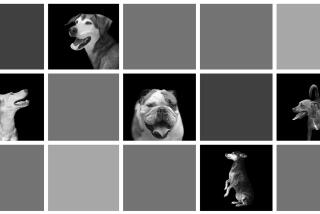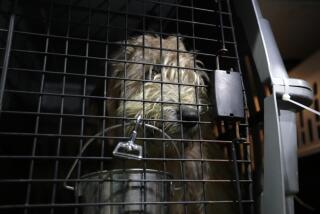COVER STORY : In the Name of Puppy Love : Animals: Local residents willingly spend hundreds, even thousands, of dollars on veterinary specialists and high-tech treatments for their pets, from teeth-cleaning to delicate surgeries.
Rumi, ailing from pancreatitis, rests on her back as a doctor uses ultrasound to scan her inflamed pancreas and liver. Max, suffering from inexplicable fainting spells, sits in an examining bay with a 24-hour electrocardiogram halter strapped to his chest and back.
And Spice, racked by fits of reverse sneezing, has a fiber-endoscope snaked down her throat to her gastrointestinal tract.
For the record:
12:00 a.m. Aug. 4, 1994 For the Record
Los Angeles Times Thursday August 4, 1994 Home Edition Westside Part J Page 3 Zones Desk 1 inches; 22 words Type of Material: Correction
Pet doctors--David G. Feldman, the subject of the July 31 cover photo, works for California Animal Hospital. His employer was misidentified in a caption.
In this age of high-tech medicine, there is nothing unusual about this array of imposing, state-of-the art diagnostic equipment--except that these patients are pets. The three animals at this West Los Angeles veterinary center, all dogs, protest only with an intermittent bark or yowl as specialists give them care akin to what their owners expect from high-priced doctors.
“We’re concerned about this dog,” said specialist David G. Feldman, viewing Rumi’s pancreas on the ultrasound monitor. “She went into a coma and almost died, got better and then had a relapse. . . . Now we just keep her on an IV and medication and see if she can heal herself.”
As medical treatment for humans has advanced in recent decades, so has veterinary medicine. The trend has been fueled by pet owners able and willing to part with hundreds, even thousands, of dollars to prolong the lives of their beloved animals. Such pet owners--and the advanced veterinary practices that serve them--are found in particularly high concentrations in upscale communities such as those on the Westside.
“It’s safe to say that Southern California and New York City are the leading areas for the cutting edge of veterinary medicine,” said Stephen J. Ettinger, a specialist widely known among veterinarians as the father of veterinary cardiology.
Small wonder, then, that the Westside has veterinary specialists in surgery, dentistry, dermatology, cardiology, internal medicine--even oncology. Unlike general veterinarians, specialists receive about eight years of veterinary education and must pass both the standard veterinary exams and board certification tests before they are formal experts.
Southland veterinarians unable to treat or diagnose complex diseases or congenital problems will refer patients to these specialists, many of whom also perform general veterinary services to keep their practices busy.
Additionally, the Westside is home to the California Animal Hospital, a center that houses about $1 million dollars worth of medical equipment. The hospital, which treated Rumi, Max and Spice, has been likened to UC Davis’ world-renowned veterinary school.
The L.A. hospital and UC Davis own the state’s only two veterinary “colorflow” Doppler ultrasound machines, a high-tech tool that shows internal organs and blood flow, yielding information that can be critical, for instance, in the diagnosis of heart problems. For about a third of what the human procedures cost, the veterinarians install pacemakers, repair faulty heart valves and do kidney dialysis.
Although no one has exact figures, Richard Holden, executive director of the Southern California Veterinary Medical Assn., says the Westside has more veterinary specialists than any other region in the state.
“This area really allows us to practice the kind of medicine we were trained to do,” said Robert B. Olds, a veterinary surgeon since 1975 who began practicing when there were only three such specialists on the Westside. “The population is well-educated, their pets are part of the family. They really put a lot of demand on us. People can afford it too. In a rural area, you would not see that kind of thing.”
Driving the demand are pet owners such as George Sarandos of Valencia, a middle school principal who spent about $2,700 to cure Spice, one of his three dogs, of her sneezing.
“People criticize and talk about the starving in Rwanda and the homeless in Santa Monica that I could give money to,” Sarandos said. “But I say (pets) are a gift from God, and he has given me enough money to care for them, and I can choose to do what I want with that money. She’s my baby. I’d mortgage my house to get that dog well. When I adopt a dog, it’s like a marriage, for better or worse.”
Suffice it to say that Sarandos and love-struck pet owners like him keep specialists in business.
Kafka, a caramel-colored stray dog, might well have gotten the “Old Yeller” treatment (a walk behind the barn and a bullet) if he’d been in a rural community. But Kafka, who has been temporarily adopted by one of Olds’ employees until she can find it a home, is the recipient of a $1,000 surgery to reconstruct a broken pelvis.
In the operating room, an out-cold Kafka, dwarfed by mammoth surgical lights overhead, is stretched out on the table and hooked up to a respirator, electrocardiogram and an IV of anesthesia. Olds slices through the hip muscle, cauterizing blood vessels as he goes.
With a tiny mallet and a tool resembling a chisel, he taps vigorously at the original fracture in the right ilium,a section of pelvic bone, to re-break it in the same place. He then fits the area with a stainless steel plate, the same type used on humans.
Holes are drilled for inch-long screws that will hold the angled plate in place, allowing the dog to walk without a limp and abating constipation caused by the collapsed hip.
“I do one of these surgeries once every two years,” said Olds. Plate surgeries were pioneered on people in the 1960s and applied to dogs in the 1970s, he said. “These dogs are in pain and their bodily functions are compromised. It is very satisfying to watch the animal be able to walk.”
At the Animal Medical Center in West Los Angeles, Mona P. Rosenburg, one of only three veterinary oncologists in Southern California, sees her terminally ill cancer patients on the floor of an examining room. She scratches their bellies, coos words of encouragement and offers milk bones or cat snacks at the end of a session. This day, she gives Pooter, a 10-year-old Welsh Corgie mix in remission from lymphoma, a dose of chemotherapy through an IV.
“What I try to do is improve the quality and quantity of life for my patients,” said Rosenburg, who estimates the cost of cancer treatment for a pet at about $3,000 a year. “The patients I see are members of the family. But if the treatment becomes worse than the disease, I stop, because I don’t believe in continuing.”
Cradling Pooter while Rosenburg administers the drug, Bill Swanson, the dog’s owner, explains: “I guess it’s empty nest syndrome. . . . We have three kids who are grown and gone. I thought I had myself talked into putting her to sleep, but I couldn’t do it. How do you make that decision? My wife would be in a mental ward if anything happened to this dog.”
Bernard Rollins, a professor of physiology and psychology at Colorado State University at Ft. Collins who studies the relationships between people and animals, said the Swansons’ devotion is not unusual--despite what could easily become a five-figure veterinary bill.
“Animals are assuming increasing importance in people’s lives because of urbanization and are often the only contact with nature,” Rollins said. “And with the disintegration of tight and extended families, people relate to animals as family members. It’s not uncommon for people . . . to spend in the six figures when treating their animals for cancer.”
Certainly not all specialty procedures are life or death matters.
Consider British-born Anthony D. Shipp, a Beverly Hills’ dog and cat dentist who is one of only 29 such specialists in the world. His services range from routine teeth-cleaning ($165 to $195), which has become increasingly popular among pet owners whose animals are living longer, to more high-tech procedures such as crowns ($585) and, in extremely rare instances, orthodontics (upward of $500).
With a metal prop holding open the mouth of Laney, a 13-year-old shepherd mix, Shipp hunches over, cutting away flaps of the dog’s gums to remove the lower right molar, deteriorated from a cavity. After breaking the tooth and drilling, Shipp, who invented a double-ended toothbrush that has a small end for cats and a large end for dogs, extracts the tooth.
“She did perfect,” says Shipp to Leslie Lazner, the dog’s owner, who stands at the operating table. Laney’s worn, stuffed bear is nearby on a shelf. “Cavities cause all sorts of problems: infections, loss of teeth. And the infection can spread through the rest of the body or into the jawbone. I tell my clients, ‘You don’t have to brush all of your pet’s teeth, just the ones you want to keep.’ ”
Few places underscore the high-tech strides being made in veterinary care more than the California Animal Hospital, home to 20 veterinarians grouped into independent practices. Each practice shares the hospital’s sophisticated radiology department.
Five of the veterinarians are board-certified specialists. In the hospital’s surgery department, specialist Scott Anderson deftly cuts a window into the vertebrae of a 6-year-old West Highland white terrier with a slipped disc, then removes disc material that resembles cottage cheese from where it had compressed the spinal chord. The dog recovers from the delicate surgery, which costs about $1,200, in an incubator sort of cubicle that controls temperature and oxygen levels.
On an operating table to Anderson’s right, surgeon Phillip J. Gill amputates a cat’s cancerous ear. Skin cancers around the eyelids, nose and remaining ear are vaporized through laser surgery, leaving the spots ashen but cancer-free.
As prone to skin cancer as a fair-skinned person, the albino cat had his left eye surgically removed last year after skin cancer weakened the eye-socket muscles.
Meanwhile, Rumi, Max and Spice, after undergoing tests at the animal hospital, receive their diagnoses and prescribed treatments.
For the wire-haired terrier Max, plagued by bouts of fainting, the problem is epilepsy and is treatable with the same medication prescribed for the disease in humans.
For the beagle, Spice, a dog with an extraordinarily good disposition--demonstrated by vigorous tail wagging during an endoscopic exam--drugs will alleviate the reverse sneezing, caused by a muscle problem in the pharynx.
But the news for Rumi, the 4-year-old chocolate Labrador whose medical bill was already more than $5,000, was not good. Exploratory surgery confirmed that she suffers from severe pancreatitis, which has caused so much stress in other organs that the dog is diabetic and has hepatitis. Unable to eat or drink, she’d have to be fed intravenously for an indefinite amount of time.
Ultimately, the dog’s owners decided that keeping Rumi alive would be selfish because the quality of her life would deteriorate and she probably would not recover.
She was put to sleep last Sunday.
“We take some comfort that we did everything that we could,” said Rumi’s owner, Michael Auerbach. “You always know that with an animal, you’ll outlive them, but you don’t expect it when they’re so young. It’s very sad. We miss her. We’ll always remember her and be happy that she was a part of our lives.”





